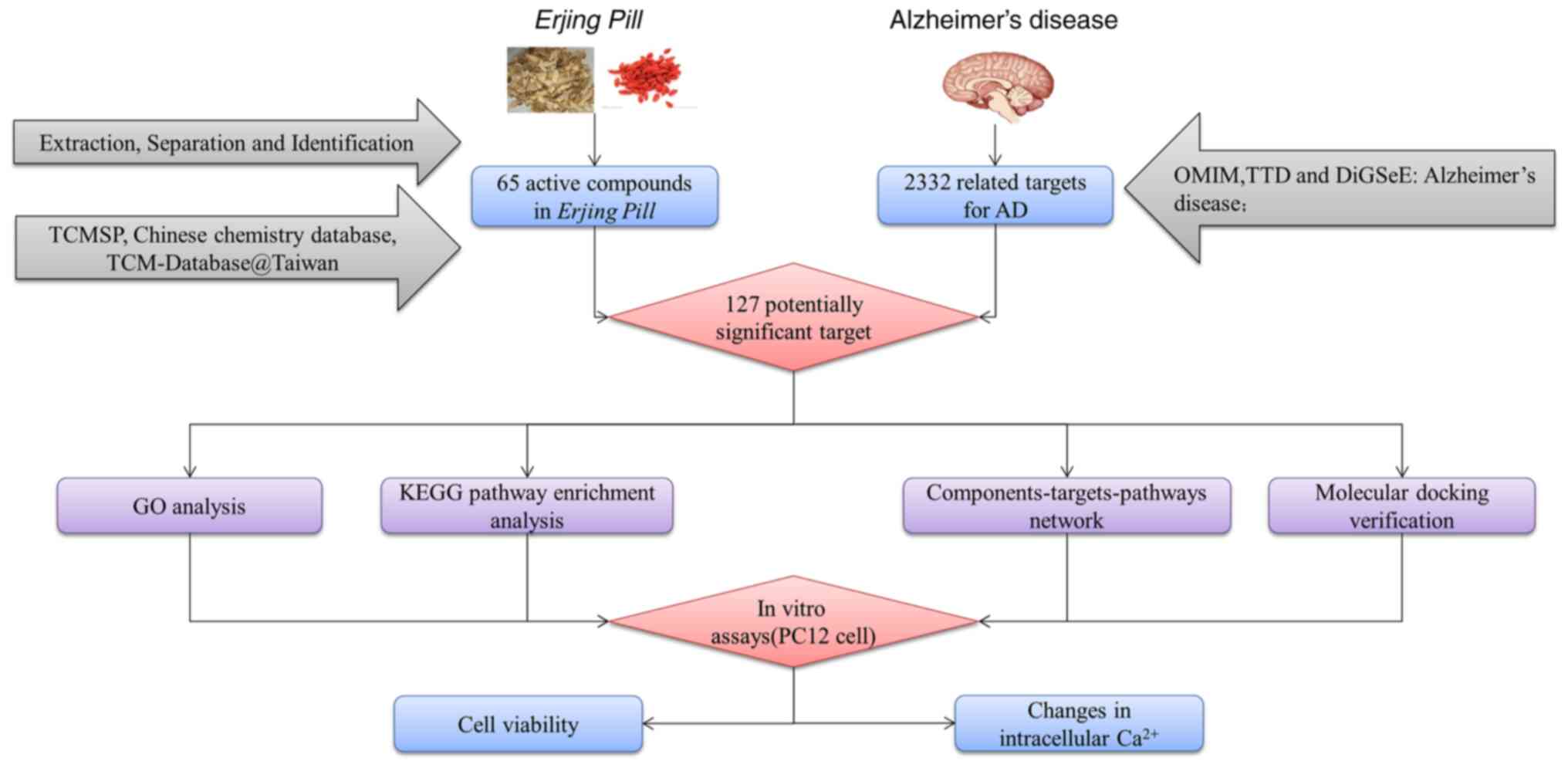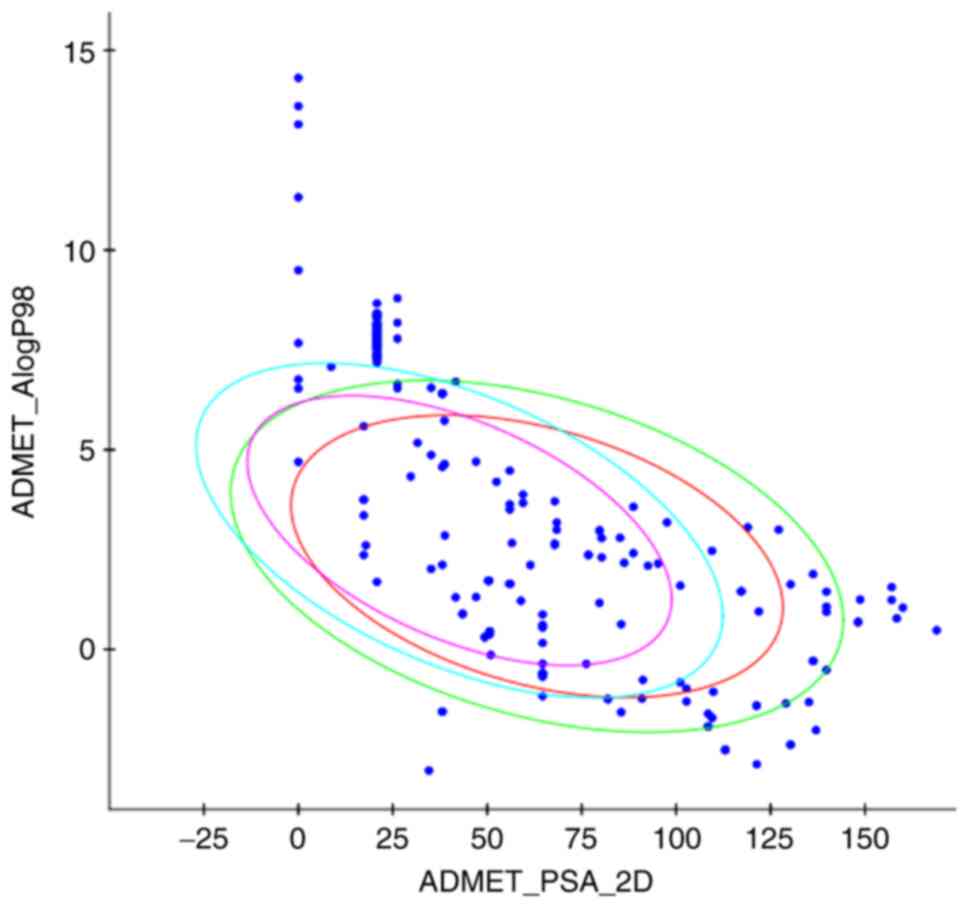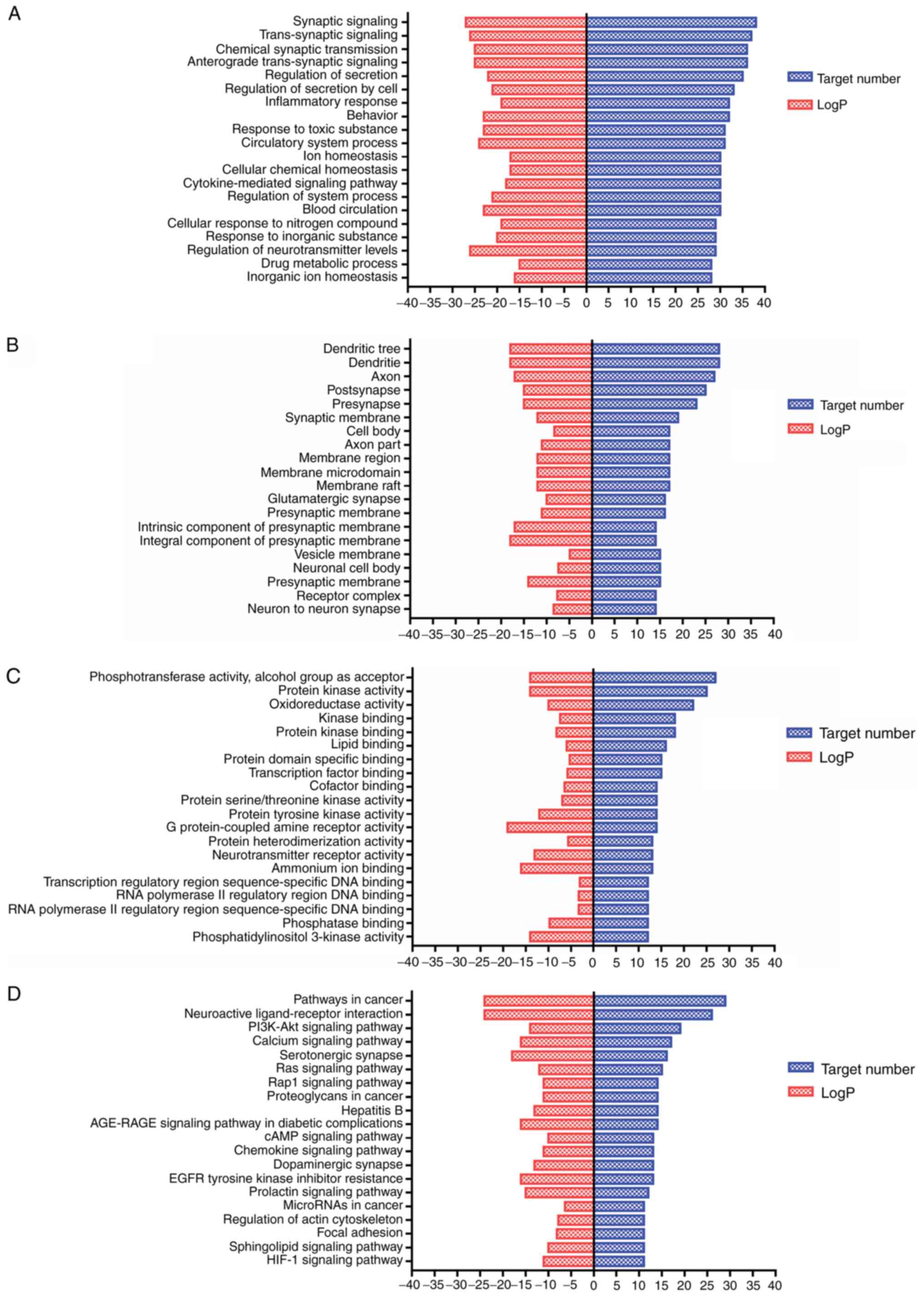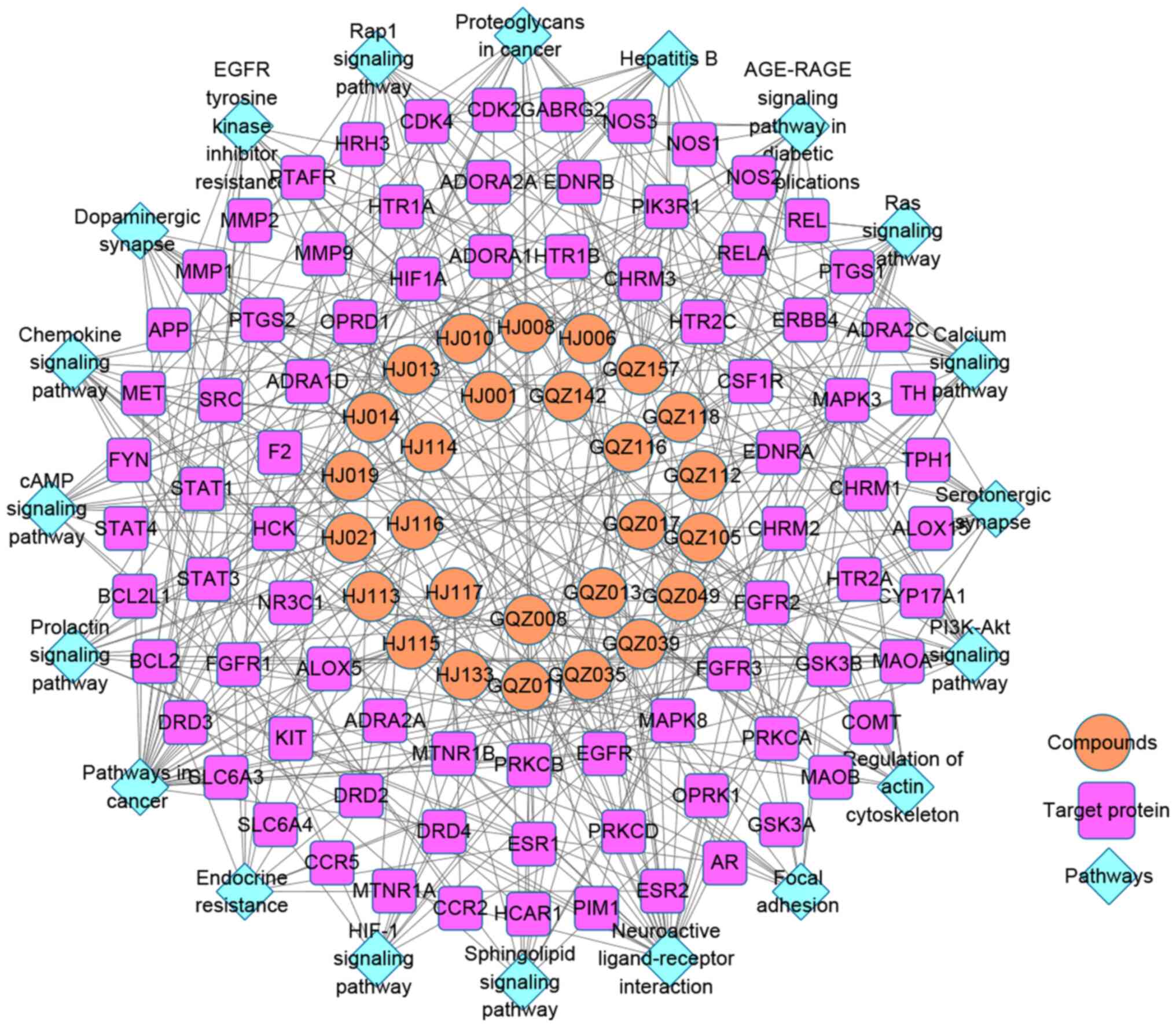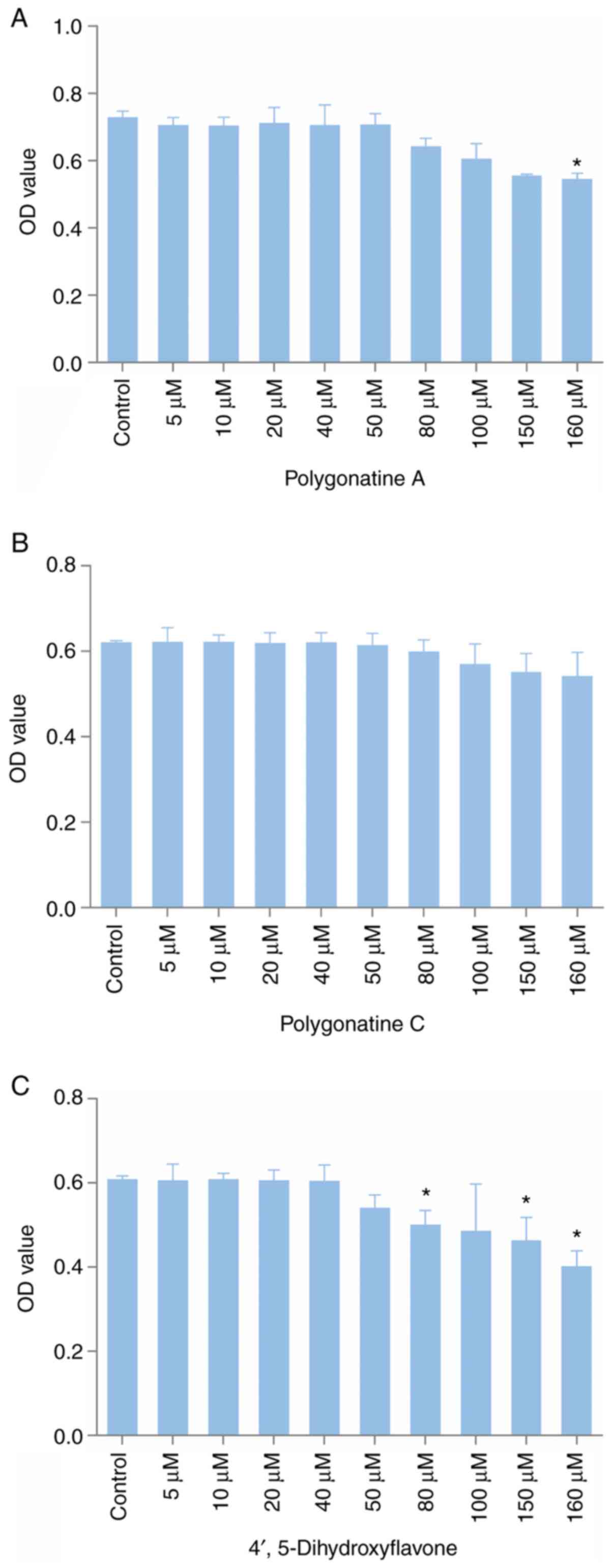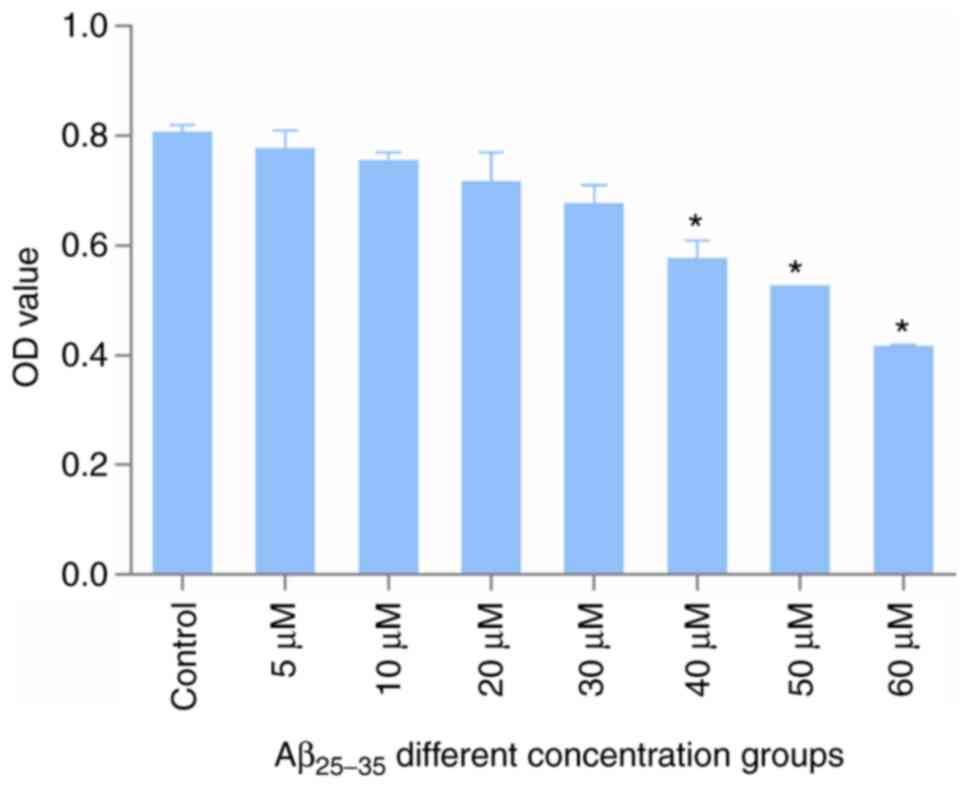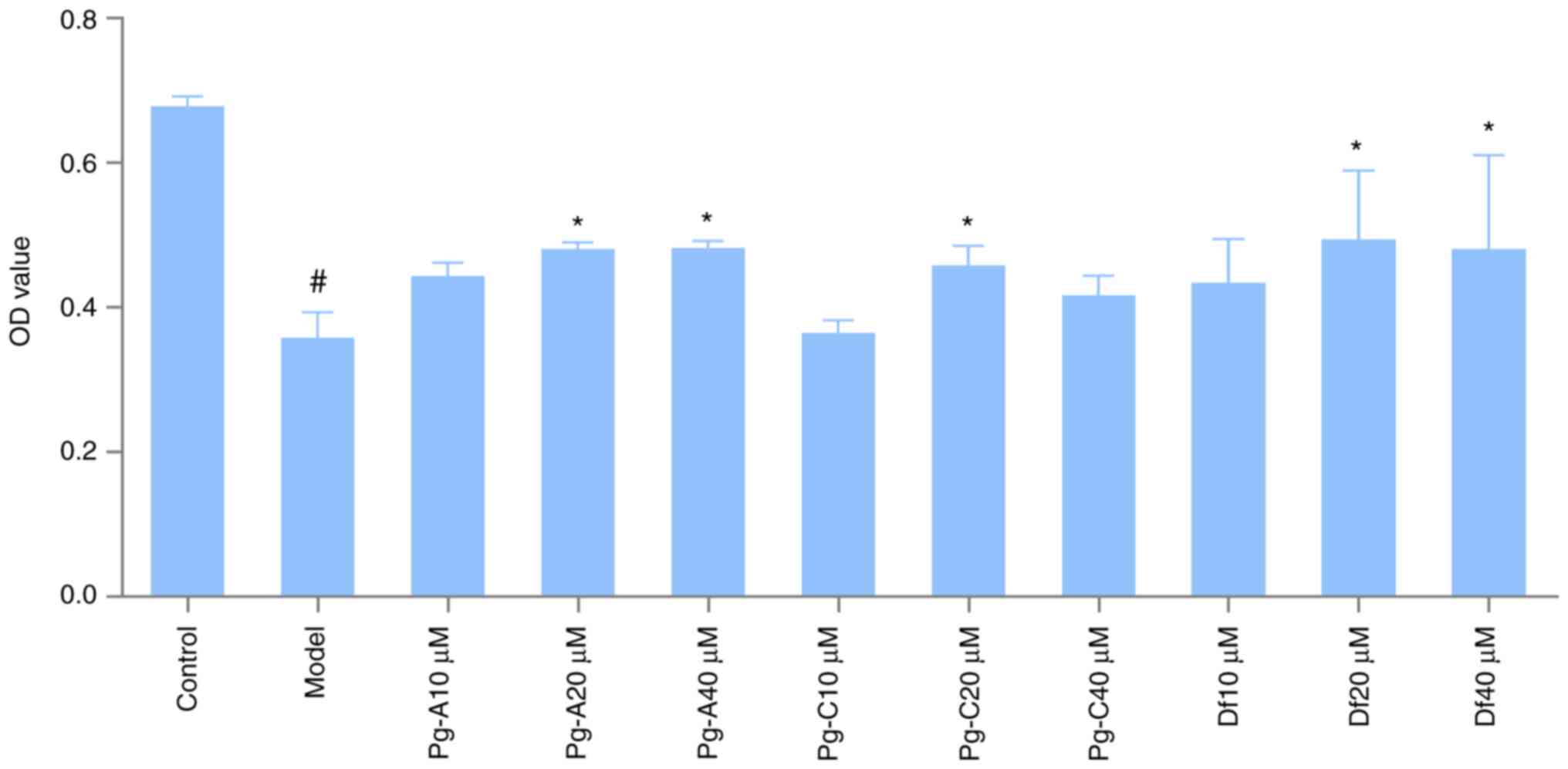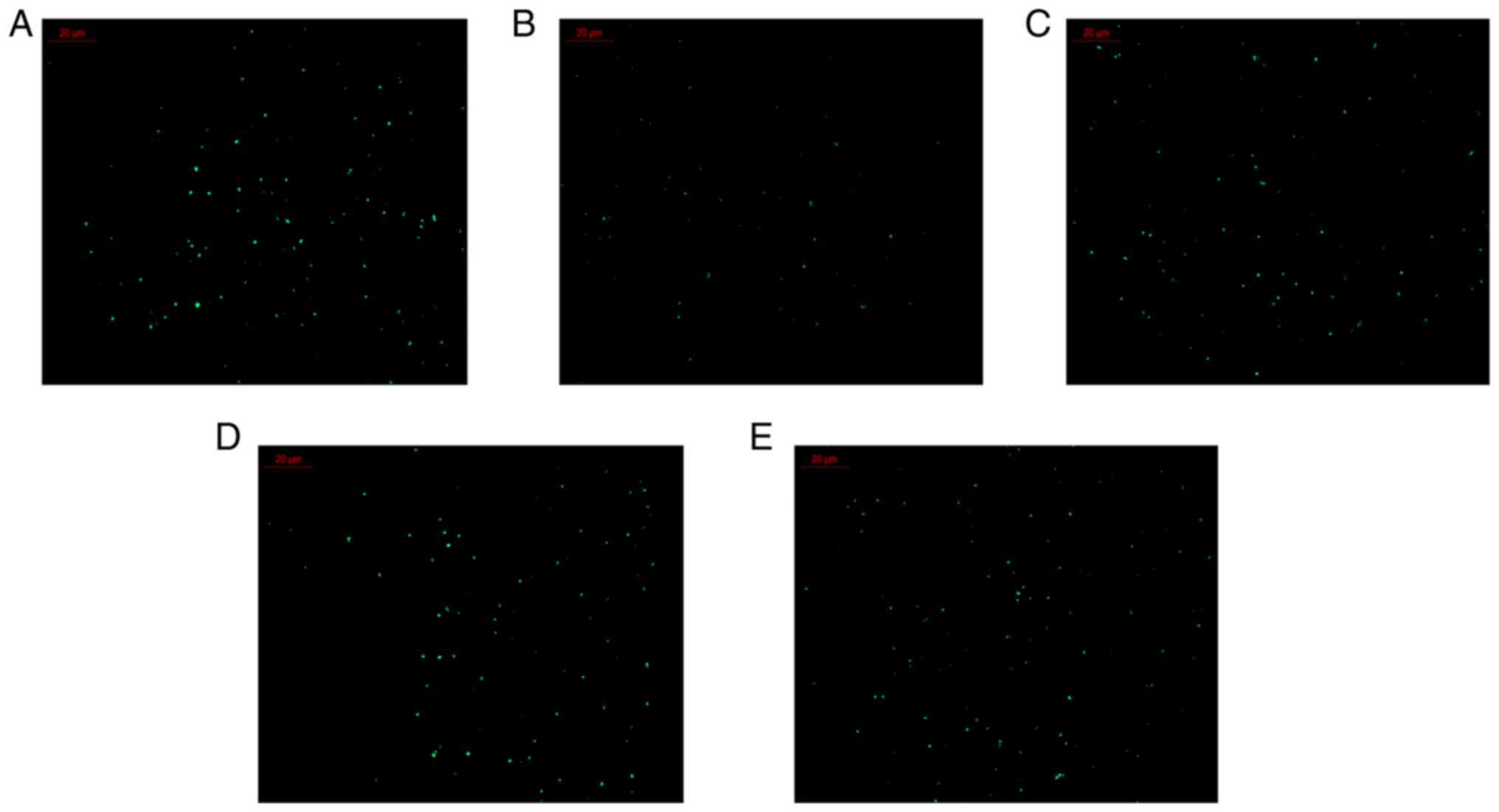|
1
|
Blennow K, Hampel H, Weiner M and
Zetterberg H: Cerebrospinal fluid and plasma biomarkers in
Alzheimer disease. Nat Rev Neurol. 6:131–144. 2010.PubMed/NCBI View Article : Google Scholar
|
|
2
|
Kozlov S, Afonin A, Evsyukov I and
Bondarenko A: Alzheimer's disease: As it was in the beginning. Rev
Neurosci. 28:825–843. 2017.PubMed/NCBI View Article : Google Scholar
|
|
3
|
Bonet-Costa V, Pomatto LC and Davies KJ:
The proteasome and oxidative stress in Alzheimer's Disease.
Antioxid Redox Signal. 25:886–901. 2016.PubMed/NCBI View Article : Google Scholar
|
|
4
|
Nisbet RM, Polanco JC, Ittner LM and Götz
J: Tau aggregation and its interplay with amyloid-β. Acta
Neuropathol. 129:207–220. 2015.PubMed/NCBI View Article : Google Scholar
|
|
5
|
Myeku N, Clelland CL, Emrani S, Kukushkin
NV, Yu WH, Goldberg AL and Duff KE: Tau-driven 26S proteasome
impairment and cognitive dysfunction can be prevented early in
disease by activating cAMP-PKA signaling. Nat Med. 22:46–53.
2016.PubMed/NCBI View
Article : Google Scholar
|
|
6
|
Zeng Q, Li L, Siu W, Jin Y, Cao M, Li W,
Chen J, Cong W, Ma M, Chen K and Wu Z: A combined molecular biology
and network pharmacology approach to investigate the multi-target
mechanisms of Chaihu Shugan San on Alzheimer's disease. Biomed
Pharmacother. 120(109370)2019.PubMed/NCBI View Article : Google Scholar
|
|
7
|
Li C, Zhang WY, Yu Y, Cheng CS, Han JY,
Yao XS and Zhou H: Discovery of the mechanisms and major bioactive
compounds responsible for the protective effects of gualou xiebai
decoction on coronary heart disease by network pharmacology
analysis. Phytomedicine. 56:261–268. 2019.PubMed/NCBI View Article : Google Scholar
|
|
8
|
Zhang Q, Li R, Peng W, Zhang M, Liu J, Wei
S, Wang J, Wu C, Gao Y and Pu X: Identification of the active
constituents and significant pathways of guizhi-shaoyao-zhimu
decoction for the treatment of diabetes mellitus based on molecular
docking and network pharmacology. Comb Chem High Throughput Screen.
22:584–598. 2019.PubMed/NCBI View Article : Google Scholar
|
|
9
|
Du YJ, Tao YM, Tian Q, Wang Y, Wang L and
Wu WH: Based on the ERK/CREB signal pathway to explore the
mechanism of moxibustion on Shenshu points to improve neuron loss
in ovariectomized AD rats with D-galactose. Chin J Trad Chin Med.
1–18. 2020.(In Chinese).
|
|
10
|
Gao YY and Wang X: The effect of ‘Kidney
and Brain Xiangji’ electroacupuncture on the behavior and
expression of IL-1b and TNF-¦Á in Alzheimer's disease model mice.
Shanghai J Acupuncture. 39:359–364. 2020.
|
|
11
|
Hao da C and Xiao PG: Network
pharmacology: A rosetta stone for traditional Chinese medicine.
Drug Dev Res. 75:299–312. 2014.PubMed/NCBI View Article : Google Scholar
|
|
12
|
Liu Q, Bai SF, Lai XJ, Wang HF, Liang J
and Lai WY: Comparison of two methods for determination of
polysaccharides in Erjing pill. Chin J Exp Trad Chin Med. 16:32–34.
2010.
|
|
13
|
Ding C, Luo J, Shu H, Zhang XY, He GX and
Zhou Y: A summary of the health effects of Shengji Erjing Recipe
and analysis of its industrialization direction. Hubei J Trad Chin
Med. 34:73–74. 2012.
|
|
14
|
Bai SF, Lai XJ, Liu Q and Lai WY: Study on
the effect of Erjing pill polysaccharide on reducing blood sugar in
diabetic rats. China Mod Appl Pharm. 27:577–580. 2010.
|
|
15
|
Li SX: Understanding and suggestions on
the variety list of ‘Food and Medicine’. Chin J Nat Med. 4:232–242.
2001.
|
|
16
|
Xie GZ, Liu H, Wang Z, Tang XY and Zhang
SH: Comparison of Polygonatum odoratum and Polygonatum odoratum, a
traditional Chinese medicine for food and medicine. Mod Chin Med.
22:1447–1152. 2020.
|
|
17
|
Han C, Zhu Y, Yang Z, Fu S, Zhang W and
Liu C: Protective effect of Polygonatum sibiricum against
cadmium-induced testicular injury in mice through inhibiting
oxidative stress and mitochondria-mediated apoptosis. J
Ethnopharmacol. 261(113060)2020.PubMed/NCBI View Article : Google Scholar
|
|
18
|
Tu MF and Ye WF: Research progress of
pharmacological effects and clinical application of Polygonatum
sibiricum. J Yichun Univ. 40:27–31. 2018.(In Chinese).
|
|
19
|
Gao Y, Wei Y, Wang Y, Gao F and Chen Z:
Lycium barbarum: A traditional Chinese herb and a promising
anti-aging agent. Aging Dis. 8:778–791. 2017.PubMed/NCBI View Article : Google Scholar
|
|
20
|
Chen LG: Analysis of pharmacological
effect and clinical application value of wolfberry. The World's
Latest Medical Information Digest. 15(92)2015.(In Chinese).
|
|
21
|
Zhang R, Zhu X, Bai H and Ning K: Network
pharmacology databases for traditional Chinese medicine: Review and
assessment. Front Pharmacol. 10(123)2019.PubMed/NCBI View Article : Google Scholar
|
|
22
|
Ahn MJ, Kim CY, Yoon KD, Ryu MY, Cheong
JH, Chin YW and Kim J: Steroidal saponins from the rhizomes of
Polygonatum sibiricum. J Nat Prod. 69:360–364.
2006.PubMed/NCBI View Article : Google Scholar
|
|
23
|
Yu HS, Zhang J, Kang LP, Han LF, Zou P,
Zhao Y, Xiong CQ, Tan DW, Song XB, Yu K and Ma BP: Three new
saponins from the fresh rhizomes of Polygonatum kingianum. Chem
Pharm Bull (Tokyo). 57:1–4. 2009.PubMed/NCBI View Article : Google Scholar
|
|
24
|
Chen YH, Yan B, Guan Y and Liu YQ: Effect
of Erjing Pills on learning and memory abilities of AD rats with
kidney yin deficiency induced by ovariectomy+D-galactose combined
with Aβ1-40. Trad Chin Drug Res Clin Pharmacol. 30:1421–1427.
2019.
|
|
25
|
Leng EL, Cao ZW, Jiang ZH, Zhou H and Liu
L: Network-based drug discovery by integrating systems biology and
computational technologies. Brief Bioinform. 14:491–505.
2013.PubMed/NCBI View Article : Google Scholar
|
|
26
|
Che CT, Wang ZJ, Chow MS and Lam CW:
Herb-herb combination for therapeutic enhancement and advancement:
Theory, practice and future perspectives. Molecules. 18:5125–5141.
2013.PubMed/NCBI View Article : Google Scholar
|
|
27
|
Zhao S and Iyengar R: Systems
pharmacology: Network analysis to identify multiscale mechanisms of
drug action. Annu Rev Pharmacol Toxicol. 52:505–521.
2012.PubMed/NCBI View Article : Google Scholar
|
|
28
|
Zeng Q, Li L, Jin Y, Chen Z, Duan L, Cao
M, Ma M and Wu Z: A network pharmacology approach to reveal the
underlying mechanisms of Paeonia lactiflora pall. On the treatment
of Alzheimer's Disease. Evid Based Complement Alternat Med.
2019(8706589)2019.PubMed/NCBI View Article : Google Scholar
|
|
29
|
Ru J, Li P, Wang J, Zhou W, Li B, Huang C,
Li P, Guo Z, Tao W, Yang Y, et al: TCMSP: A database of systems
pharmacology for drug discovery from herbal medicines. J
Cheminform. 6(13)2014.PubMed/NCBI View Article : Google Scholar
|
|
30
|
UniProt Consortium: UniProt: A hub for
protein information. Nucleic Acids Res. 43 (Database
Issue):D204–D212. 2015.PubMed/NCBI View Article : Google Scholar
|
|
31
|
Hähnke VD, Kim S and Bolton EE: PubChem
chemical structure standardization. J Cheminform.
10(36)2018.PubMed/NCBI View Article : Google Scholar
|
|
32
|
Gene Ontology Consortium. Gene ontology
consortium: Going forward. Nucleic Acids Res. 43 (Database
Issue):D1049–D1056. 2015.PubMed/NCBI View Article : Google Scholar
|
|
33
|
Safran M, Dalah I, Alexander J, Rosen N,
Iny Stein T, Shmoish M, Nativ N, Bahir I, Doniger T, Krug H, et al:
GeneCards version 3: The human gene integrator. Database (Oxford).
2010(baq020)2010.PubMed/NCBI View Article : Google Scholar
|
|
34
|
Li YH, Yu CY, Li XX, Zhang P, Tang J, Yang
Q, Fu T, Zhang X, Cui X, Tu G, et al: Therapeutic target database
update 2018: Enriched resource for facilitating bench-to-clinic
research of targeted therapeutics. Nucleic Acids Res. 46
(D1):D1121–D1127. 2018.PubMed/NCBI View Article : Google Scholar
|
|
35
|
Amberger JS and Hamosh A: Searching online
mendelian inheritance in man (OMIM): A knowledgebase of human genes
and genetic phenotypes. Curr Protoc Bioinformatics.
58:1.2.1–1.2.12. 2017.PubMed/NCBI View Article : Google Scholar
|
|
36
|
Kim J, So S, Lee HJ, Park JC, Kim JJ and
Lee H: DigSee: Disease gene search engine with evidence sentences
(version cancer). Nucleic Acids Res. 41 (Web Server
Issue):W510–W517. 2013.PubMed/NCBI View Article : Google Scholar
|
|
37
|
Liu X, Shi Y, Deng Y and Dai R: Using
molecular docking analysis to discovery Dregea sinensis Hemsl.
Potential mechanism of anticancer, antidepression, and
immunoregulation. Pharmacogn Mag. 13:358–362. 2017.PubMed/NCBI View Article : Google Scholar
|
|
38
|
Daina A and Zoete V: Application of the
SwissDrugDesign online resources in virtual screening. Int J Mol
Sci. 20(4612)2019.PubMed/NCBI View Article : Google Scholar
|
|
39
|
Qiao B, Wu Y, Li X, Xu Z, Duan W, Hu Y,
Jia W, Fan Q and Xing H: A network pharmacology approach to explore
the potential mechanisms of Yifei Sanjie formula in treating
pulmonary fibrosis. Evid Based Complement Alternat Med.
2020(8887017)2020.PubMed/NCBI View Article : Google Scholar
|
|
40
|
Lotia S, Montojo J, Dong Y, Bader GD and
Pico AR: Cytoscape app store. Bioinformatics. 29:1350–1351.
2013.PubMed/NCBI View Article : Google Scholar
|
|
41
|
Chen CY: TCM Database@Taiwan. The world's
largest traditional Chinese medicine database for drug screening in
silico. PLoS One. 6(e15939)2011.PubMed/NCBI View Article : Google Scholar
|
|
42
|
Su WT and Shi YA: Nanofiber containing
carbon nanotubes enhanced PC12 cell proliferation and
neuritogenesis by electrical stimulation. Biomed Mater Eng. 26
(Suppl 1):S189–S195. 2015.PubMed/NCBI View Article : Google Scholar
|
|
43
|
Ning HH, Yuan MM, Wu QP, Ping YH, Zhou ZQ,
Xu Y, Wu Y and Yin HX: Separation and identification of chemical
constituents of Polygonatum multiflorum. Chin J Exp Formulas.
24:77–82. 2018.
|
|
44
|
Yi BX, Zhong LY and Gong QF: Jiangxi
Jianchang's special Wen method and its modern research ideas.
Lishizhen Trad Chin Med. 23:1755–1756. 2012.
|
|
45
|
Chen H, Feng SS and Sun YJ: Research
progress on chemical constituents and pharmacological activities of
three kinds of medicinal Huangjing. Chin Herbal Med. 46:2329–2338.
2015.
|
|
46
|
Ma K, Huang XF and Kong LY: Steroidal
saponins from Polygonatum cyrtonema. Chem Nat Compd. 49:888–891.
2013.
|
|
47
|
Yu HS, Ma BP, Kang LP, Zhang T, Jiang FJ,
Zhang J, Zou P, Zhao Y, Xiong CQ, Tan DW, et al: Saponins from the
processed rhizomes of Polygonatum kingianum. Chem Pharm Bull
(Tokyo). 57:1011–1014. 2009.PubMed/NCBI View Article : Google Scholar
|
|
48
|
Yu HS, Ma BP and Song XB: Two new
steroidal saponins from the processed Polygonatum kingianum. Helv
Chim Acta. 93:1086–1092. 2010.PubMed/NCBI View Article : Google Scholar
|
|
49
|
Nakanishi T, Inada A, Kambayashi K and
Yoneda K: Flavonoid glycosides of the roots of Glycyrrhiza
uralensis. Phytochemistry. 24:339–341. 1985.
|
|
50
|
Aida K, Tawata M, Shindo H, Onaya T,
Sasaki H, Yamaguchi T, Chin M and Mitsuhashi H: Isoliquirigenin: A
new aldose reductase inhibitor from glycyrrhizae radix. Planta Med.
56:254–258. 1990.PubMed/NCBI View Article : Google Scholar
|
|
51
|
Sun LR, Li X and Wang SX: Two new
alkaloids from the rhizome of Polygonatum sibiricum. J Asian
Nat Prod Res. 7:127–130. 2005.PubMed/NCBI View Article : Google Scholar
|
|
52
|
Wang YF, Lu CH, Lai GF, Cao JX and Luo SD:
A new indolizinone from Polygonatum kingianum. Planta Med.
69:1066–1068. 2003.PubMed/NCBI View Article : Google Scholar
|
|
53
|
Chiquita S, Rodrigues-Neves AC, Baptista
FI, Carecho R, Moreira PI, Castelo-Branco M and Ambrósio AF: The
retina as a window or mirror of the brain changes detected in
Alzheimer's disease: Critical aspects to unravel. Mol Neurobiol.
56:5416–5435. 2019.PubMed/NCBI View Article : Google Scholar
|
|
54
|
Ma J, Chen X, Bian YQ, Chen ZJ, Qiao YJ
and Zhang YL: Study on efficacy markers of Salviae Miltiorrhizae
Radix et Rhizoma for promoting blood circulation and remving blood
stasis based on systematic traditional Chinese medicine. Zhongguo
Zhong Yao Za Zhi. 45:3259–3265. 2020.PubMed/NCBI View Article : Google Scholar : (In Chinese).
|
|
55
|
Xu XQ, Huang JY, Zhao T, Tu XY, Huang BB,
Gao SL, Xiao BQ, Luo L and Zhao XF: Mechanism of total
polysaccharides from Erjing Pill against learning and memory
impairment in rats with long-term stress. J Jiangxi College Trad
Chin Med. 19:54–57. 2007.
|
|
56
|
Huang JY, Zhou J, Wei H, Tu XY and Lou LY:
Pharmacological experimental study of compound Erigo against
Alzheimer's Disease. J Jiangxi Med College. 41:53–56. 2001.
|
|
57
|
Xu XQ, Huang JY, Luo R, Xiao BQ, Zhao T
and Tu XY: Effect of the effective fraction of Erjing Pill on
learning and memory impairment in rats with kidney-yin deficiency
model and its molecular mechanism. Chin Trad Herbal Drugs.
38:564–569. 2007.
|
|
58
|
Capatina L, Todirascu-Ciornea E, Napoli
EM, Ruberto G, Hritcu L and Dumitru G: Thymus vulgaris essential
oil protects zebrafish against cognitive dysfunction by regulating
cholinergic and antioxidants systems. Antioxidants (Basel).
9(1083)2020.PubMed/NCBI View Article : Google Scholar
|
|
59
|
Baumann K, Kordić L, Močibob M, Šinko G
and Tomić S: Synthesis and in vitro screening of novel heterocyclic
β-d-Gluco- and β-d-galactoconjugates as butyrylcholinesterase
inhibitors. Molecules. 24(2833)2019.PubMed/NCBI View Article : Google Scholar
|
|
60
|
Galvão F Jr, Grokoski KC, Silva BB, Lamers
ML and Siqueira IR: The amyloid precursor protein (APP) processing
as a biological link between Alzheimer's disease and cancer. Ageing
Res Rev. 49:83–91. 2019.PubMed/NCBI View Article : Google Scholar
|
|
61
|
Craig D, Donnelly C, Hart D, Carson R and
Passmore P: Analysis of the 5HT-2A T102C receptor polymorphism and
psychotic symptoms in Alzheimer's disease. Am J Med Genet B
Neuropsychiatr Genet. 144B:126–128. 2007.PubMed/NCBI View Article : Google Scholar
|
|
62
|
Ma LQ, Liu C, Wang F, Xie N, Gu J, Fu H,
Wang JH, Cai F, Liu J and Chen JG: Activation of
phosphatidylinositol-linked novel D1 dopamine receptors inhibits
high-voltage-activated Ca2+ currents in primary cultured striatal
neurons. J Neurophysiol. 101:2230–2238. 2009.PubMed/NCBI View Article : Google Scholar
|
|
63
|
DeTure MA and Dickson DW: The
neuropathological diagnosis of Alzheimer's disease. Mol
Neurodegener. 14(32)2019.PubMed/NCBI View Article : Google Scholar
|
|
64
|
Park HJ, Kwon H, Lee JH, Cho E, Lee YC,
Moon M, Jun M, Kim DH and Jung JW: β-Amyrin ameliorates Alzheimer's
disease-like aberrant synaptic plasticity in the mouse hippocampus.
Biomol Ther (Seoul). 28:74–82. 2020.PubMed/NCBI View Article : Google Scholar
|
|
65
|
Ledo JH, Azevedo EP, Beckman D, Ribeiro
FC, Santos LE, Razolli DS, Kincheski GC, Melo HM, Bellio M,
Teixeira AL, et al: Cross talk between brain innate immunity and
serotonin signaling underlies depressive-like behavior induced by
Alzheimer's Amyloid-β oligomers in mice. J Neurosci.
36:12106–12116. 2016.PubMed/NCBI View Article : Google Scholar
|
|
66
|
de Jong IEM and Mørk A: Antagonism of the
5-HT(6) receptor-Preclinical rationale for the treatment of
Alzheimer's disease. Neuropharmacology. 125:50–63. 2017.PubMed/NCBI View Article : Google Scholar
|
|
67
|
Ferrero H, Solas M, Francis PT and Ramirez
MJ: Serotonin 5-HT6 receptor antagonists in Alzheimer's
disease: Therapeutic rationale and current development status. CNS
Drugs. 31:19–32. 2017.PubMed/NCBI View Article : Google Scholar
|
|
68
|
Krashia P, Nobili A and D'Amelio M:
Unifying hypothesis of dopamine neuron loss in neurodegenerative
diseases: Focusing on Alzheimer's disease. Front Mol Neurosci.
12(123)2019.PubMed/NCBI View Article : Google Scholar
|
|
69
|
Nardone R, Höller Y, Thomschewski A, Kunz
AB, Lochner P, Golaszewski S, Trinka E and Brigo F: Dopamine
differently modulates central cholinergic circuits in patients with
Alzheimer disease and CADASIL. J Neural Transm (Vienna).
121:1313–1320. 2014.PubMed/NCBI View Article : Google Scholar
|
|
70
|
Huang LP, Yang XY, Yan B and Qiu XP:
Effect of Erjing Pill on hippocampal proteomics of AD rats with
kidney yin deficiency induced by ovariectomy + D-galactose combined
with Aβ_ (1-40). Chin J Exp Pharmacol. 26:15–22. 2020.PubMed/NCBI View Article : Google Scholar
|
|
71
|
Sun BJ and Ling H: Research progress on
the relationship between dopamine receptors and Alzheimer's
disease. J Clin Ration Use. 8:177–180. 2015.
|
|
72
|
Lian YX and He L: Therapeutic effects of
dopamine D1 receptor agonists on central nervous system diseases
and their target pathways. J of Clin Rational Use. 6:102–103.
2013.(In Chinese).
|
|
73
|
Nafar F, Clarke JP and Mearow KM: Coconut
oil protects cortical neurons from amyloid beta toxicity by
enhancing signaling of cell survival pathways. Neurochem Int.
105:64–79. 2017.PubMed/NCBI View Article : Google Scholar
|
|
74
|
Han F, Xu H, Shen JX, Pan C, Yu ZH, Chen
JJ, Zhu XL, Cai YF and Lu YP: RhoA/Rock2/Limk1/cofilin1 pathway is
involved in attenuation of neuronal dendritic spine loss by paeonol
in the frontal cortex of D -galactose and aluminum-induced
Alzheimer’s disease-like rat model. Acta Neurobiologiae
Experimentalis. 80:225–244. 2020.PubMed/NCBI
|
|
75
|
Li BL, Li X and Li JC: Metabolomics study
on serum of Tg2576 mice transgenic model of Alzheimer's disease.
Chin J Exp Anim. 25:218–224. 2017.
|
|
76
|
Sethiya NK, Nahata A, Singh PK and Mishra
SH: Neuropharmacological evaluation on four traditional herbs used
as nervine tonic and commonly available as Shankhpushpi in India. J
Ayurveda Integr Med. 10:25–31. 2019.PubMed/NCBI View Article : Google Scholar
|
|
77
|
Liu X: Study on the limiting rate enzyme
of tryptophan metabolism IDO1 and its inhibitors. Chem Life.
6:774–782. 2016.
|
|
78
|
Preciados M, Yoo C and Roy D: Estrogenic
endocrine disrupting chemicals influencing NRF1 regulated gene
networks in the development of complex human brain diseases. Int J
Mol Sci. 17(2086)2016.PubMed/NCBI View Article : Google Scholar
|
|
79
|
Nakazawa T, Yasuda T, Ueda J and Ohsawa K:
Antidepressant-like effects of apigenin and
2,4,5-trimethoxycinnamic acid from perilla frutescens in the forced
swimming test. Biol Pharm Bull. 26:474–480. 2003.PubMed/NCBI View Article : Google Scholar
|















